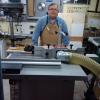OK, I'm getting all wrapped around the axle on operating my new 8" jointer. Here's the problem: I have a crowned board that I want to face joint flat. I place the board on the jointer in the "frown" position then feed into the jointer blades. Where do I apply downward pressure to the board as it first makes contact with the blades, and where do I apply downward pressure on the board as it passes over the blades until the pass is completed? It seems that downward pressure can be applied at the very front and very rear edges of the board only; applying downward pressure at any time over the middle of the board will defeat the effort to flatten the board (and will leave me with a thinner and still crowned board. If only applying pressure on front and rear edges, I'm going to find myself in an awkward (and dangerous) stance on longer boards.
Help!!!!





 Reply With Quote
Reply With Quote



 Jr.
Jr. 



 .
.

